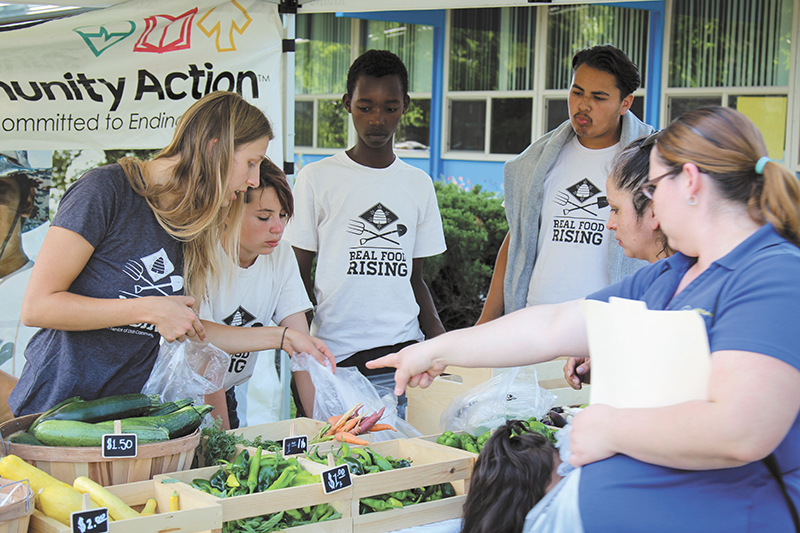
No Gas for Green Goods: Try Walking to Urban Greens Market
Food: Interviews & Features
For many living on Salt Lake City’s west side, a few essentials that many enjoy can be just out of reach. Things like quick trips to the store can be tricky if you don’t have a car. Transportation can be one of the greatest hindrances in helping families enjoy healthy meals if there isn’t a grocery store within close walking distance to a home, and some are forced to compromise the health of their families by grabbing quick food fixes at gas stations or fast-food joints because they are nearby and cheap. Those two brown bananas and that crusty-looking apple at your local five-and-dime could be the best selection for some families.
A recent Community Food Assessment identified the Glendale and Poplar Grove areas in Salt Lake as food deserts, where individuals are having to deal with limited food resources. According to Bridget Stuchly, Program Manager with SLC’s Sustainability Department, SLCgreen, these areas have “low supermarket access and some of the lowest vehicle ownership rates in the city.”
With the support of a USDA grant, SLCgreen has teamed up with The Green Urban Lunch Box, Utahns Against Hunger and Salt Lake Community Action Program’s Real Food Rising to establish Urban Greens Market, five pop-up markets that provide fresh and local produce within walking distance to community members.
“Community members we spoke with were incredibly frustrated with the lack of options that exist in their neighborhoods and were excited to now have the opportunity to walk over to one of the five locations to shop,” Stuchly says. “Not only do community members benefit, [but] the farmers supplying the produce for the market now have five additional outlets through which to sell their fruits and vegetables.”
I spent an afternoon hanging out at the Neighborhood House pop-up market with a crew of farm-wise teens and a few neighborhood chickens ogling a beautiful selection of freshly grown peppers, a variety of tomatoes, zucchini, squash and other early-harvest goods. The majority of the produce sold at the markets is locally grown, and much comes from Real Food Rising’s large community garden located next to the Neighborhood House pop-up market. Green Urban Lunch Box also provides fruit for the markets.
The markets do provide some fruits and vegetables that weren’t grown locally, such as bananas, because there is demand from the community for them. According to Sara Simmons, who oversees the Neighborhood House market, “People coming to the market can be surprised by what is available at different times of year,” she says. “They don’t know that you can’t buy everything year round, so we work to educate and talk about how the garden works.”
In addition to fresh food, these pop-up markets provide work and experience to teenagers. Real Food Rising, according to their website, “uses sustainable agriculture to empower teens with the skills they need to thrive while increasing access to healthy food in Salt Lake.” The organization hires teens ages 14–17 to work in their garden and sell produce in the Urban Greens Markets. Lilly Slack, a 15-year-old from Salt Lake, is getting her first experience working in a garden. “I’ve always wondered about how my food gets from the farm to my table,” she says. “I get to learn about growing food and how the people that live here need it. The community is grateful to get to walk here and buy good food.”
Simmons mentioned that teens are also getting experience and training in several job-related skills through the work they do growing and selling produce. “They do workshops and learn about public speaking, working as a team and helping the community,” she says. Lilly chimed in again to mention writing resumes, learning how to interview for jobs and participating in a guided communication exercise called Real Talk, in which staff and teens can give each other feedback on what they are doing well or what they can work on.
Utahns Against Hunger helps patrons of the markets stretch their food dollars a little further with the Double Up Food Bucks program, which doubles the amount of money that individuals using SNAP EBT Cards can spend—up to $10 per market day. Brian Emerson, Community Food Systems Coordinator at Utahns Against Hunger, says, “Double Up Food Bucks help low-income families have access to fresh, affordable local foods, often grown in their neighborhoods.”
Moving forward, Stuchly hopes to see the program continue to grow and better meet the food needs of the community. “We hope that the Urban Greens Market will be a success and that we will be able to expand the program to other areas of the city for urban agriculture so we can grow more food—food [that] is affordable and healthy,” she says.
Urban Greens Market manifests as stands in various locations around Glendale and Poplar Grove throughout the week and will be open through Nov. 14. You can find hours of operation and additional info about the markets at slcgreen.com, or you can text MARKET to 51555 to receive updates on available produce and more. Be sure to catch Green Urban Lunch Box’s 35-foot school bus/greenhouse/mobile farmers market at the Urban Greens Market pop-ups that they oversee.